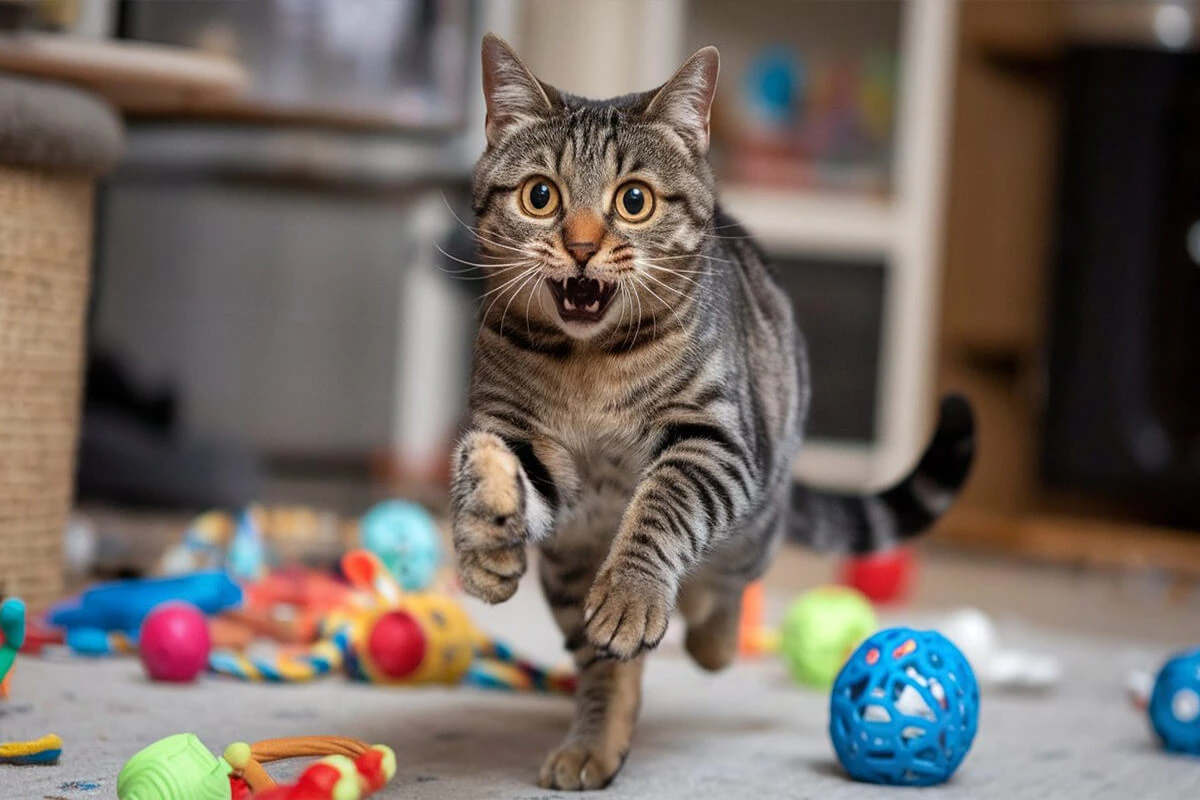Cats can be adorable, loving companions, but sometimes they display behavior that seems completely unhinged—what many cat owners call cat insanity. One moment, your cat lounges peacefully in the sun; the next, it’s sprinting across the room, knocking things over, or randomly attacking your feet. These bursts of unpredictable energy, also known as cat zoomies, can leave owners wondering if their furry friend has lost its mind. However, these behaviors usually stem from natural instincts, environmental factors, or even underlying anxiety.
Understanding crazy cat behavior is essential for any cat parent who wants to create a calm and happy home. Cats are complex creatures with unique psychological needs, and their erratic actions often serve a purpose. Whether your cat is hyperactive, overly aggressive during play, or showing signs of feline anxiety, knowing the difference between normal playfulness and deeper behavioral issues can help you respond appropriately.
By recognizing the causes behind cat insanity, you can take the right steps to provide cat stress relief, prevent unwanted behaviors, and strengthen the bond with your furry friend. This guide will explore the reasons behind why cats act crazy, the most common hyperactive behaviors, and expert-backed strategies to help calm an anxious or overactive cat. Let’s dive into the world of feline psychology and learn how to handle your unpredictable companion!
Understanding Cat Insanity: Why Do Cats Act Crazy?
The Science Behind Cat Insanity Behavior
Cats might seem unpredictable, but cat insanity—those wild bursts of energy and sudden mood shifts—actually follows a pattern rooted in their instincts and natural biology. In the wild, cats rely on short, intense bursts of speed and energy to hunt small prey. Even though house cats don’t need to hunt for survival, their natural instincts remain strong. This explains why a cat will suddenly dart across the house, climb furniture, or pounce on invisible prey—these behaviors mimic hunting movements and contribute to what many owners perceive as crazy cat behavior.
Another major factor behind cat insanity is their unique sleep-wake cycle. Pick a neutral area where neither pet feels like it belongs there. If a cat spends most of the day napping, it will likely experience a surge of energy in the evening, leading to cat zoomies, erratic play, and unpredictable hyperactivity. These high-energy moments can confuse owners, but they are a normal part of a cat’s daily rhythm.
Beyond instinct, a cat’s brain plays a major role in crazy cat behavior. Feline neurology differs from human brain function, and their heightened senses make them react to stimuli we don’t notice. A cat might suddenly jump, run, or stare into space because it detects a distant sound, subtle vibration, or unfamiliar scent. Their sharp awareness, combined with their instinct to stay alert, often results in behavior that appears random or “insane” to humans. However, these actions are simply a part of a cat’s natural instincts and heightened perception of their environment.
Common Triggers for Hyperactive Cats
Hyperactive cats don’t just act wild for no reason—certain triggers can send them into overdrive. One of the most common causes of excessive energy is boredom and lack of stimulation. Cats need mental and physical enrichment to stay balanced. Without enough playtime, they might release pent-up energy in chaotic ways, like climbing curtains, attacking feet, or racing around the house.
Environmental factors also play a huge role in feline hyperactivity. Sudden noises, unfamiliar scents, or even a change in routine can make a cat act erratically. If a cat experiences feline stress triggers like loud music, visitors, or a new pet in the house, it may react with zoomies, excessive meowing, or even aggressive behavior.
Another overlooked trigger is diet. Cats that eat a low-quality or high-carbohydrate diet may experience spikes in energy similar to sugar rushes in humans. A proper, protein-rich diet helps maintain balanced energy levels and prevents erratic mood swings.
Lastly, certain health conditions, such as feline anxiety or hormonal imbalances, can cause unpredictable behavior. Cats suffering from anxiety may react by pacing, overgrooming, or acting aggressively. Understanding these triggers helps cat owners manage their pet’s hyperactivity more effectively.
When to Be Concerned
Not all hyperactive behavior is normal or healthy. While playful zoomies and spontaneous bursts of energy are usually harmless, some behaviors may signal a deeper issue. If a cat suddenly becomes hyperactive after years of calm behavior, this could indicate a medical problem, such as hyperthyroidism or neurological disorders. A sudden change in activity level, especially in senior cats, warrants a trip to the vet.
Excessive aggression, even during play, is another red flag. If a cat bites too hard, hisses frequently, or swats at people without provocation, it may be experiencing cat anxiety or stress-related behavioral issues. Similarly, compulsive behaviors, such as tail chasing, overgrooming, or relentless pacing, often point to underlying stress or medical conditions.
If a cat’s hyperactivity becomes destructive or leads to self-injury, intervention is necessary. Providing cat stress relief, adjusting the environment, and consulting a veterinarian for advice can help address serious behavioral concerns before they escalate.
By recognizing what drives cat insanity, cat owners can better manage their pet’s energy, reduce stress, and ensure their feline friend remains happy and healthy.
The Most Common Hyperactive Behaviors in Cats
Cat Zoomies Explained
Your cat suddenly sprints across the room at full speed, leaps onto the furniture, and dashes through the hallway like it’s being chased by an invisible force. These intense bursts of energy, often labeled as cat insanity, are known as cat zoomies. While they may seem chaotic, they are completely normal and serve as a way for cats to release built-up energy or react to something in their environment.
Several factors trigger crazy cat behavior, with pent-up energy being one of the most common causes. Cats sleep for long hours—often up to 16 hours a day. When they wake up, especially after a deep sleep, they experience a sudden surge of energy that needs to be burned off quickly. This often results in high-speed sprints that seem random but actually follow a natural pattern.
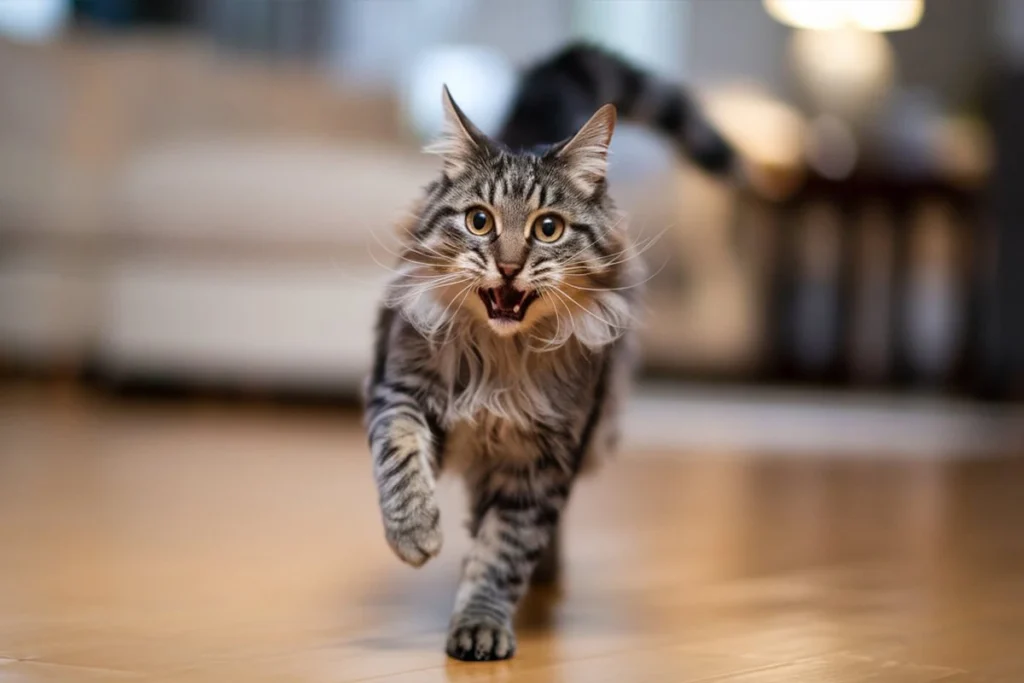
Another major cause of cat zoomies is their predatory instinct. Even though house cats don’t need to hunt for survival, their bodies remain wired for stalking and chasing prey. If a cat hasn’t had enough interactive playtime during the day, zoomies may act as an outlet for those suppressed hunting instincts. Without proper stimulation, hyperactive cats often display erratic energy bursts, reinforcing the need for regular play sessions.
Litter box zoomies are another curious but common form of cat insanity. Some cats dash around immediately after using the litter box, possibly due to the feeling of relief after elimination, an instinctive response to avoid predators detecting their scent, or even discomfort caused by an unclean litter box.
While cat zoomies are harmless in most cases, excessive or frequent episodes could indicate an underlying issue. Cats that constantly exhibit hyperactive behavior, especially at night, may need more stimulation, a better diet, or environmental adjustments. Providing cat stress relief through scheduled playtime, mental enrichment, and environmental consistency helps reduce excessive zoomies and supports a balanced, happy cat.
Aggressive Play vs. True Aggression
Many cats play rough, but not all aggressive behavior is playful. Understanding the difference between aggressive play and true aggression helps prevent unwanted scratching, biting, and negative interactions.
Play aggression is a normal part of a cat’s behavior, especially in kittens and young cats. A playful but excited cat may pounce, chase, or even lightly bite during play. These actions mimic how cats would practice hunting in the wild. A playful cat typically maintains a relaxed body posture, ears forward, and no signs of fear or distress.
In contrast, true aggression stems from fear, territorial disputes, or overstimulation. An aggressive cat often hisses, growls, flattens its ears, and dilates its pupils before attacking. Unlike playful biting, aggressive biting is harder and often accompanied by defensive body language, such as arched backs or puffed-up fur.
Several factors contribute to aggressive behavior. A cat may lash out if it feels cornered, experiences feline anxiety, or reacts to an unfamiliar scent. Rough play can also escalate into aggression if the cat becomes overstimulated. Some cats that didn’t learn proper bite inhibition as kittens may also play too aggressively.
If a cat frequently shows signs of aggression, owners should focus on calming anxious cats through structured play, positive reinforcement, and avoiding punishment, which can make aggression worse. Providing plenty of interactive toys and environmental enrichment can redirect excessive energy into healthy outlets.
Overstimulation and Sudden Biting
One moment, you’re petting your cat, and the next, it bites or swats at you. Many cat owners experience this sudden switch from affection to aggression, often without warning. This reaction occurs because of overstimulation, a common issue where a cat becomes too sensitive to touch.
Cats can only handle a certain amount of touching or petting before they feel uncomfortable. While some cats enjoy extended petting, others become irritated after just a few strokes. Certain areas, such as the belly, lower back, or base of the tail, can be particularly sensitive. When a cat reaches its limit, it may react with a quick nip, swat, or even a full-on bite to signal that it has had enough.
Overstimulation can also result from excitement during play. If a cat becomes too engrossed in rough play, it may suddenly switch from playful biting to real aggression. The key to preventing overstimulation bites is learning to read a cat’s body language. Twitching tails, flattened ears, skin rippling, or dilated pupils often signal that a cat is reaching its tolerance limit.
To avoid overstimulation, owners should keep petting sessions brief and watch for early warning signs. Sticking to short, positive interactions helps prevent negative reactions. If a cat frequently reacts aggressively to touch, providing cat calming techniques such as slow blinking, gentle play, or pheromone diffusers can help it feel more at ease.
By understanding these common hyperactive behaviors, cat owners can create a more harmonious environment and strengthen their bond with their feline friends. Recognizing the difference between normal play, overstimulation, and aggression allows owners to adjust their interactions and provide the right cat stress relief methods.
How to Calm an Anxious or Hyperactive Cat
Environmental Enrichment for Cats
A bored cat often becomes a hyperactive or anxious cat. Without proper stimulation, cats may develop destructive behaviors, excessive meowing, or restlessness. Environmental enrichment keeps a cat mentally and physically engaged, reducing stress and preventing boredom-related behavioral issues.
Start by creating a space that allows natural feline behaviors like climbing, scratching, and exploring. Cat trees, shelves, and window perches give cats vertical space, which helps them feel safe and in control of their environment. Cats instinctively seek high ground to observe their surroundings, so adding tall structures can reduce stress and boost confidence.
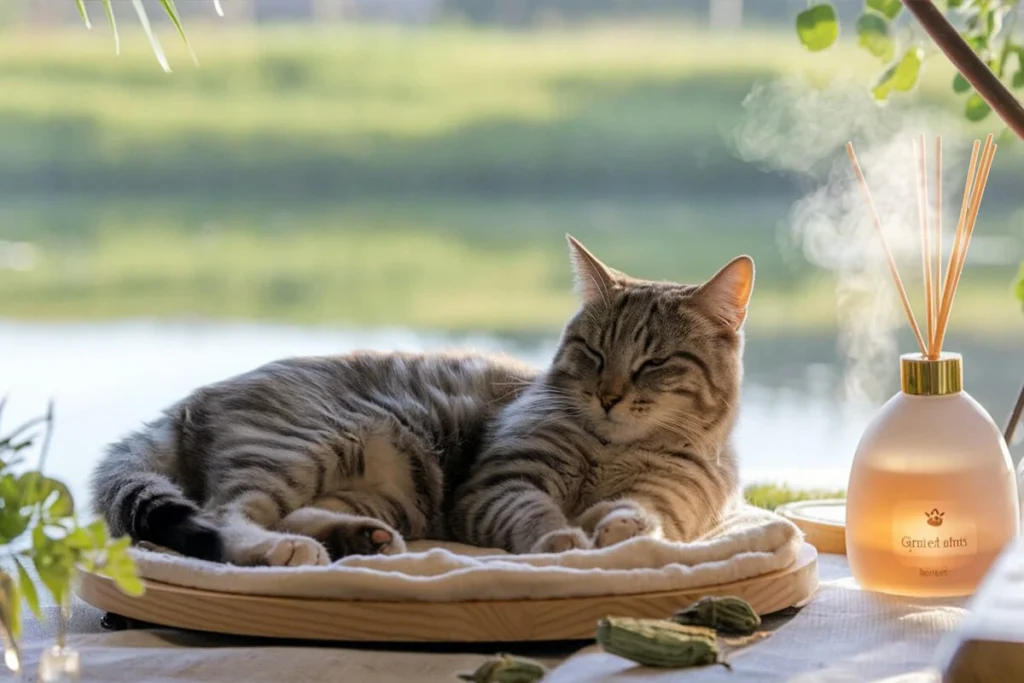
Scratching is another essential feline behavior. Providing scratching posts and pads prevents destructive clawing on furniture while giving cats a healthy outlet for energy. Place scratching posts in areas where your cat naturally spends time to encourage use.
Interactive toys also play a vital role in environmental enrichment. Rotating different types of toys, such as feather wands, laser pointers, and treat-dispensing puzzle toys, keeps a cat engaged and prevents boredom. These toys mimic hunting behaviors, allowing a cat to expend energy in a productive way.
For cats who spend most of their time indoors, adding elements of sensory stimulation improves their well-being. Place a bird feeder outside a window to provide visual entertainment, introduce cat-safe plants like cat grass or catnip, and use different textures in bedding and play areas to make their space more engaging.
By designing an enriched environment, you give your cat multiple ways to stay active and mentally stimulated, reducing the likelihood of hyperactive behavior caused by boredom.
Cat Calming Techniques
Some cats naturally feel more anxious than others. Whether a cat startles easily, reacts negatively to new situations, or becomes aggressive when overstimulated, using calming techniques helps create a more relaxed and comfortable environment.
One of the simplest ways to calm a cat involves using slow, deliberate movements and a soft voice. Cats pick up on human emotions, so staying calm and speaking gently reassures them. Avoid sudden movements or loud noises, which can trigger stress responses.
Pheromone diffusers and sprays, such as Feliway, mimic natural feline calming scents and help reduce anxiety. Plugging a pheromone diffuser into an area where the cat spends most of its time can create a sense of security. Spraying a pheromone-based solution on bedding or scratching posts can further enhance its calming effects.
Another effective technique involves slow blinking and non-threatening body language. Cats interpret slow blinking as a sign of trust. If a cat seems nervous, making eye contact and slowly closing your eyes before reopening them can communicate safety and reassurance. Many cats will respond by relaxing or blinking back.
For more hands-on calming, gentle petting or massage can help some cats feel secure. However, knowing your cat’s boundaries is essential—some cats enjoy physical touch, while others become overstimulated quickly. If a cat shows signs of discomfort, such as twitching tails or flattened ears, give it space.
Creating a consistent daily routine also helps anxious cats feel more secure. Feeding, playtime, and sleep schedules should remain predictable to prevent unnecessary stress. If changes need to be made, introducing them gradually minimizes anxiety.
Best Ways to Provide Cat Stress Relief
Cats experience stress for many reasons, including changes in routine, new environments, or unfamiliar people and animals. Providing effective stress relief keeps a cat emotionally balanced and prevents anxiety-driven behaviors.
Interactive play sessions serve as one of the best stress relievers. A structured play routine using wand toys, balls, or electronic toys helps cats release built-up tension in a healthy way. Engaging in play before mealtime mimics natural hunting patterns, making a cat feel fulfilled and relaxed.
Safe hiding spots and retreat areas give cats a place to decompress when they feel overwhelmed. Cozy cat beds in quiet corners, covered hideouts, or enclosed cat caves provide a sense of security. If a cat becomes stressed, allowing it to retreat to a familiar, safe space prevents further anxiety.
Background noise and white noise machines can also help calm nervous cats, especially in loud households. Soft classical music, nature sounds, or even a running fan can create a more soothing environment.
For particularly anxious cats, natural calming aids like CBD oil, chamomile, or valerian root may provide relief. Always consult a veterinarian before introducing any supplements to ensure safety.
If a cat’s stress levels remain high despite environmental adjustments and calming techniques, seeking veterinarian advice becomes essential. Underlying health issues, chronic pain, or deeper anxiety disorders may require professional intervention.
By combining environmental enrichment, structured calming techniques, and targeted stress relief, cat owners can help their feline friends feel safe, secure, and happy in their homes.
Cat Anxiety Solutions: Helping Your Feline Friend Stay Balanced
Recognizing Signs of Feline Anxiety
Cats don’t always show stress in obvious ways. Unlike dogs, who might whimper or pace when anxious, cats often express anxiety through subtle behavioral and physical changes. Recognizing these early warning signs helps prevent feline anxiety from escalating into serious behavioral issues.
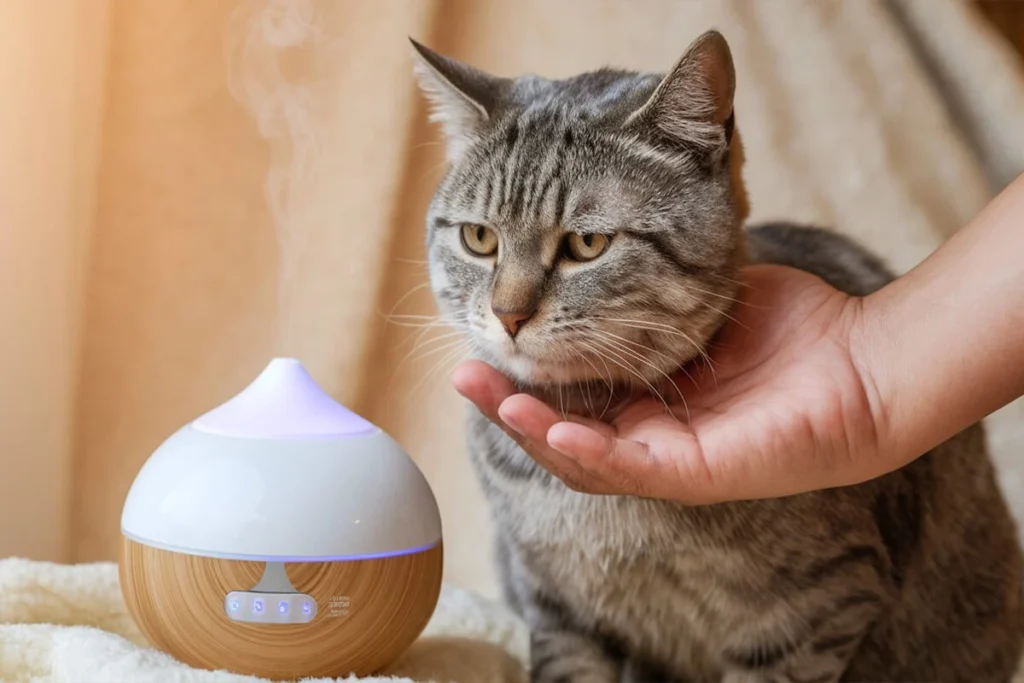
One of the most common signs of anxiety is excessive hiding. While many cats enjoy quiet alone time, an anxious cat may retreat to hiding spots for extended periods and avoid interaction, even with trusted family members. If a cat suddenly refuses to leave a hiding place, anxiety or fear may be the cause.
Changes in grooming habits also indicate stress. Some anxious cats overgroom to the point of creating bald spots or irritated skin. Others may neglect grooming altogether, leading to a rough, unkempt coat. Both behaviors signal emotional distress and require attention.
Anxiety can also affect a cat’s litter box habits. A stressed cat may urinate outside the litter box, spray urine on walls or furniture, or avoid using the box altogether. These behaviors often result from territorial anxiety, fear, or discomfort in their environment.
Vocalization patterns change when a cat feels anxious. Increased meowing, yowling, or excessive chirping—especially at night—suggests stress or a need for reassurance. On the other hand, some cats become unusually quiet when feeling uneasy.
Aggressive or destructive behaviors sometimes emerge in anxious cats. A cat experiencing stress may swat, bite, or hiss more frequently, even towards familiar people. Destructive scratching on furniture or knocking over objects can also stem from nervous energy.
Recognizing these behaviors early helps cat owners take proactive steps to reduce stress and prevent further anxiety-related issues.
How to Reduce Stress in Cats
Reducing a cat’s stress starts with creating a calm, predictable environment. Cats thrive on routine, so maintaining consistent feeding, play, and sleep schedules helps them feel secure. Even small changes in routine—such as moving furniture, introducing a new pet, or changing work hours—can cause stress, so introducing changes gradually minimizes anxiety.
Providing safe spaces where a cat can retreat when feeling overwhelmed is essential. Cat caves, enclosed beds, or high perches give cats a sense of security. If a home has multiple pets, offering separate areas for eating, resting, and litter box use helps reduce territorial stress.
Interactive play is one of the most effective ways to relieve stress. Engaging a cat in play sessions using feather wands, laser pointers, or puzzle feeders mimics hunting instincts and provides mental stimulation. Regular play burns off excess energy and redirects anxious behavior into positive outlets.
Using calming aids can also help an anxious cat feel more at ease. Pheromone diffusers, sprays, or calming collars release synthetic feline facial pheromones, which create a sense of familiarity and safety. Some cats respond well to natural remedies like chamomile, valerian root, or catnip, but always consult a veterinarian before using any herbal supplements.
Creating quiet zones away from loud noises, visitors, or household activity allows anxious cats to decompress. Soft music, white noise machines, or nature sounds can further enhance relaxation by masking disruptive noises.
For cats that struggle with separation anxiety, leaving enrichment toys, treat puzzles, or interactive feeders helps keep them occupied when alone. Spending quality time together through gentle petting or brushing also reassures cats and strengthens the human-animal bond.
By addressing anxiety triggers and providing structured stress relief, cat owners can create a more comfortable and emotionally stable environment for their feline companions.
Veterinarian Advice for Cats with Anxiety
If cat insanity persists despite environmental adjustments, seeking veterinarian advice becomes crucial. Some signs of crazy cat behavior or excessive anxiety may stem from underlying medical conditions such as pain, thyroid imbalances, or neurological issues. A veterinarian can rule out these health problems and determine whether physical discomfort contributes to feline anxiety and stress-related behaviors.
In extreme cases, vets may recommend anti-anxiety medications for cats struggling with chronic stress. Some hyperactive cats benefit from short-term use of medications like fluoxetine (Prozac for cats) or amitriptyline, which help regulate mood and reduce anxiety-driven behaviors. However, medication should always be a last resort and must be combined with behavioral modifications and environmental enrichment to ensure long-term improvement.
For cats suffering from severe stress, trauma-related anxiety, or aggressive cat behavior, working with a feline behaviorist can provide specialized strategies to help retrain fearful or defensive reactions. Behavior modification techniques, such as desensitization and counterconditioning, gradually reduce stress triggers and build a cat’s confidence. These techniques help rewire a cat’s response to anxiety-inducing situations, making them more comfortable and secure in their environment.
Regular veterinarian checkups play a crucial role in monitoring a cat’s emotional well-being. Consistently assessing a cat’s stress levels ensures that anxiety symptoms don’t escalate over time. By combining medical advice, structured calming techniques, and a stable home environment, cat owners can manage cat insanity and help their anxious cats feel safe, relaxed, and emotionally balanced.
Preventing Behavioral Issues Before They Start
The Role of Routine and Consistency
Cats thrive on predictability. Sudden changes in their daily routine can trigger cat insanity, leading to stress, hyperactivity, and even destructive behavior. Establishing a consistent schedule for feeding, playtime, and sleep helps create a sense of security, which is essential for a cat’s mental well-being.
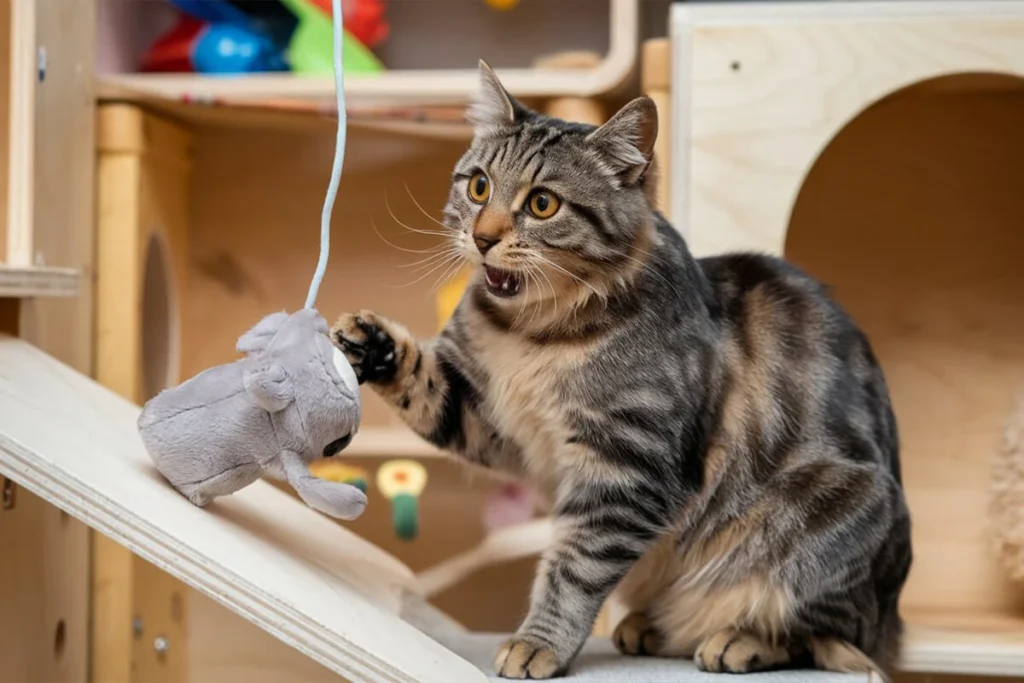
A structured routine reduces feline anxiety and prevents erratic behavior like excessive zoomies, aggressive play, or random scratching. Cats feel most comfortable when they know what to expect, so keeping their daily activities predictable prevents unnecessary stress.
Feeding schedules play a major role in keeping a cat calm and balanced. Cats instinctively follow a hunt-eat-groom-sleep cycle. Feeding at the same times each day mimics their natural hunting routine and prevents anxious behaviors like excessive meowing, food aggression, or overeating. Avoid free-feeding, as it can lead to obesity and energy bursts at random times.
A consistent play schedule also helps manage crazy cat behavior. Cats release pent-up energy through interactive play, but when their play sessions are unpredictable, they may act out in undesirable ways. Playtime before meals, for example, satisfies their instinct to hunt and helps them wind down for a restful nap afterward.
Routine extends beyond feeding and play—litter box maintenance, social interactions, and sleep areas should also remain predictable. Keeping litter boxes in a stable location, maintaining a clean environment, and providing consistent interaction from family members help a cat feel safe. If changes need to be made, introducing them gradually prevents unnecessary stress.
By sticking to a stable routine, cat owners can reduce hyperactivity, prevent stress-related behavioral issues, and create a peaceful, well-balanced environment that prevents cat insanity.
The Power of Proper Playtime
A cat’s wild instincts drive them to stalk, chase, and pounce. Without an outlet for these behaviors, cats often exhibit hyperactive behavior that seems chaotic or aggressive. Structured, engaging play sessions not only prevent crazy cat behavior but also improve a cat’s mental and physical health.
Cats need interactive play, not just passive toys left on the floor. Wand toys, feather teasers, and laser pointers mimic hunting movements, allowing cats to satisfy their predatory instincts in a controlled way. These activities help burn excess energy, reducing feline anxiety and minimizing destructive behaviors like scratching furniture or attacking ankles.
Playtime also strengthens the human-cat bond. Engaging with a cat through play builds trust and provides positive mental stimulation. Cats that receive regular interactive play tend to be more affectionate and less prone to erratic behaviors.
To maximize the benefits of play, follow a structured approach:
- Start with slow movements – Imitate the way prey would naturally behave. Move a wand toy slowly at first to capture the cat’s attention.
- Increase intensity – Allow the cat to chase, leap, and pounce to burn off energy.
- Let the cat “catch” the prey – Always allow the cat to win by grabbing the toy. This mimics a successful hunt and provides satisfaction.
- End with a calming activity – After an intense play session, offer food or treats to complete the hunt-eat-groom-sleep cycle.
For cats prone to overstimulation or aggressive play, keeping play sessions short (10-15 minutes) and scheduled at the same times daily helps maintain balance. Providing puzzle toys or solo play options for independent playtime also prevents restlessness when owners aren’t available.
Proper play keeps a cat engaged, reduces stress, and prevents cat insanity by giving them a healthy way to release energy.
Healthy Diet and Mental Well-being
Nutrition plays a key role in preventing crazy cat behavior and maintaining emotional balance. A poor diet leads to energy spikes, mood swings, and increased stress, while a well-balanced diet supports cat mental health and stability.
High-quality, protein-rich diets help regulate energy levels. Cats are obligate carnivores, meaning their bodies require animal-based proteins for proper function. Low-quality diets filled with fillers like corn, wheat, or soy can lead to hyperactive behavior, digestive issues, and even anxiety. Feeding a cat high-protein, grain-free food supports stable energy levels and prevents erratic mood shifts.
Meal timing also affects behavior. Free-feeding can contribute to weight gain and irregular energy bursts, while scheduled meals help maintain a consistent energy cycle. Feeding a cat after an evening play session can prevent nighttime zoomies and promote restful sleep.
Hydration is another important factor in cat mental health. Dehydration leads to irritability, lethargy, and poor digestion. Encouraging water intake through fresh water sources or cat fountains prevents mood imbalances caused by dehydration.
Some supplements support emotional well-being. Omega-3 fatty acids, probiotics, and taurine aid brain function and reduce inflammation, promoting a calmer temperament. Natural calming supplements, such as L-theanine or CBD oil, may also help reduce stress in particularly anxious cats, but always consult a veterinarian for advice before introducing new supplements.
By providing a nutritionally balanced diet, proper hydration, and structured meal times, cat owners can significantly improve their feline’s emotional stability and prevent cat insanity from uncontrolled energy bursts or mood swings.
By maintaining routine and consistency, engaging in structured play, and feeding a well-balanced diet, cat owners can prevent hyperactive episodes, reduce anxiety, and create a peaceful, stable home environment. Understanding how to meet a cat’s natural needs helps prevent crazy cat behavior and ensures a happy, well-adjusted furry companion.
Conclusion: Managing Cat Insanity for a Happy and Healthy Feline
Understanding and managing cat insanity requires patience, consistency, and a deep awareness of feline behavior. Cats may exhibit hyperactivity, zoomies, or erratic behavior for various reasons, but these actions often stem from natural instincts, environmental triggers, or underlying stress. By recognizing the causes of crazy cat behavior, cat owners can take proactive steps to create a more balanced and harmonious home.
Establishing routine and consistency helps cats feel secure. Predictable schedules for feeding, playtime, and rest prevent anxiety and reduce random bursts of energy. A well-structured daily routine keeps a cat’s mental state stable and minimizes behavioral issues linked to stress or boredom.
Providing proper environmental enrichment allows a cat to engage in healthy physical and mental stimulation. Climbing structures, scratching posts, and interactive toys prevent destructive behaviors while giving cats an outlet for their natural instincts. Regular interactive play sessions channel excess energy, preventing hyperactivity and aggressive play.
Addressing cat mental health through stress relief techniques, calming aids, and veterinarian advice ensures a cat’s emotional well-being. Cats that receive the right balance of stimulation, attention, and relaxation experience fewer behavioral problems and form stronger bonds with their owners.
By combining structured playtime, a high-quality diet, and a stable environment, cat owners can manage cat insanity effectively. Understanding a cat’s needs transforms chaotic energy into playful companionship, ensuring a happy, well-adjusted feline friend. When cats feel safe, engaged, and properly cared for, their behavior reflects a healthy and content state of mind.
Is Your Cat Sneezing A lot, You Need To Read This.
Learn The Reason of Cats Coughing Here.
You Can Read More About Cats Here!
Find Some Good stuff for your Cat on Pet MD Official
